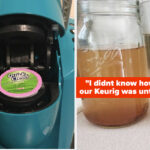BRACKISHWATER
This is water that has more salinity than fresh water, but not as much as sea water. It result the from mixing of sea water with fresh water, its salinity ranges from 0.5 – 30 (ppt.)
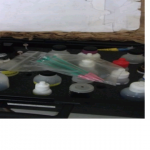
In this section, i’ll expose you to;
Its characteristics.
Its salinity determination using hand-held refractometer.
Determination of tidal range of the pond.
Identification of mangrove trees found there.
Its organism mainly oyster, periwinkle, tilapia species, crabs, mud-skipper, barracuda etc.
Construction of oyster cage
Soil found in brackish water commonly called Chikoko soil.
The water control structure
Importance of brackish organism
Importance of tide measurement
CHARACTERISTICS OF BRACKISH WATER
the characteristics of brackish water include but are not limited to the following;
Its salinity fluctuates, ranging from 0.5-35ppt, it increases during the rainy season and decreases during dry season.
It water is supplied tidally, increasing with increase in tide and verse versa.
Presence of mangrove trees
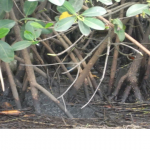
Has a unique type of soil commonly called chikoko soil with pungent rotten egg odour. It is used in pond construction in brackish water and in the amendment of collapsing dyke.
Presence of brackish organisms like oyster, mud-skipper, periwinkle, crab etc.
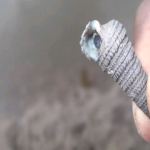
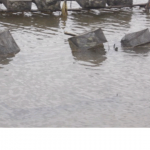
Salinity determination
the salinity of brackish water is determined using hand-held refractometer. The water sample was collected using salt free object and place on the lens of the hand held refractometer and then viewed. This is repeated for three or more times and then the average reading is taken. This exercise is carried out daily to note the salinity changes. The refractometer is well calibrated internally for proper reading.
PRECAUTIONS WHEN USING REFRACTOMETER
avoid using hand to collect the water because the salt content in the body no matter how small, can affect the salinity value.
Determination of tidal range.
The tidal range was determined with a long meter rule; this was done by Deeping it inside the pond. I observed that the water volume increased when there was high tide and decreased when the tide was low. the essence of tidal measurement is to enable us knows the best time to harvest in the brackish water. I observed that the tide comes and go in six hour interval.
Precautions that taken before measurement
*avoid zero error before taken my reading by checking the first value that start up the calibration to be sure it start from zero
*When taking reading of various pond, clean the mark created by the initial reading and wait a little for it to dry before taking another reading
be careful to avoid error due to parallax
Identification of mangrove
Here I’ll talk about the two main types of mangrove tree found in the brackish water which were the white and Red mangrove.
Similarities between both the white and red mangrove
Both has aerial root
Both serves as habitual home for oyster
Both are used in the construction of oyster rank and are used as source of fuel.
Difference between the white and red mangrove.
Table showing the difference between the mangrooves
Red mangrove
White mangrove
It has well projected aerial root
It has limited aerial root
It has long slender fruit like legume
It has short and round fruit
It has short and round leaf
It has long and slender leaf structure
Identification of brackish organisms
various organism found in the brackish water environment. Mullet, Tilapia, Snapper, Mudskipper, Bara coda, Archerfish, Lung fish , crab, Oyster, Periwinkle etc. most of them visit the environment for reproductive purpose while some have it as its permanent habitat e,g Oyster and periwinkle
My supervisor taught me more about oyster, which is one of the major shell fish reared in the brackish water, and Bara coda which is used to regulate tilapia prolific pattern of reproduction
OYSTER
Common name: Mangrove oyster
Scientific name: Crasso streagasar
Oyster shell fish were well cultivated in Buguma brackish water. Oysters are shell fish found associated with the mangrove vegetation which is common in the delta. Mangrove use the aerial root for its breath and oyster use it as its substrate. They get attached to it and remain till they die. Oyster settles naturally below water level but not in the bottom mud.
Oyster is a native species of Niger delta with good environment, good salinity. They settle as spart and grow to adult level. They are culturable species. It is an aquaculture species. It can be reared in captivity.
OYSTER CULTURING
Look for the seed (spart) either from the wide or hatchery. They are obtained from the wild by cutting mangrove root to which they are usually attached.
Soak the cut mangrove root in water (brackish water) for at least 12 hours to soften the root. While in the water protect them from predators like crab.
After soaking those in the water dislodge from the root by whirling them till they are out.
Collect the dislodge oyster spart in your recruitment container.
Stock in the oyster spart in to already prepared protective cage against predators like crab.
Arrange your oyster cage and place on a prepared stand or rack at least 30cm above the bottom which must be covered at flow of the tide. Tie the cages to the stand so that it does not float off. Do it with good rope. Then servicing of the rank is essential at least once in every two week this is done by removing the mud and blockage in the cage; this is done to ensure the proper flow of the water current through the cages which bring food for the oyster because they are filter feeder.
Chikoko soil-The soil found in the environment is purely acidic in nature. it compose of dead root of mangrove,and is called “CHIKOKOSOIL it has a pungent rotten egg odour characteristic. It is used in pond construction in the brackish water and in the amendment of collapsing dyke.
The water control structure
The water control structure in the brackish water fish pond must be able to take water and send it out, hence it serve dual purpose. This is performing by the sluice gate.
MANAGEMENT OF BRACKISH WATER FISH POND
After every cropping season, ensure you cut all the grasses in the pond area, repair linkage, ensure that silutation does not affect the pond, that sluice gate does not leak. Repair every crack around the sluice gate, crack and linkage in pond dyke, repair broken screen.
IMPORTANCES OF BRACKISHWATER ORGANISMS
Oyster serve as source of calcium, the shell contains high concentrate of calcium which is used by pharmaceutical company and in feed production.
Periwinkle serve as source of protein and calcium to man .
Mangrove root serve as good source of fuel.
Chikoko soil is used in pond construction in the brackish water.
Periwinkle shell is used in the production of hard concrete when mixed with cement.
The fish served as source of protein when eaten and source of income generation when sold.
Sent by Sir Joel N. An aquaculture expert,and Gistwheel editor,Science and nature.




